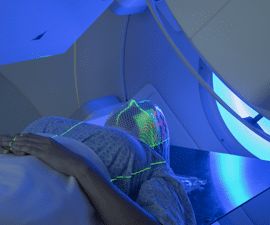
Treatment Options
Radiation Therapy

Radiation therapy (also called radiotherapy) uses high-energy x-rays to kill cancer cells and shrink tumors. Radiation is a local therapy, which means it only affects cancer cells in the treated area. Radiation is sometimes used alone for certain localized lymphomas, either nodal or extranodal, or may be combined with chemotherapy.
A radiation field is the term used to describe the part of the body selected to receive radiation therapy. Radiation is generally confined to lymph nodes and the areas immediately surrounding lymph nodes or the area of origin if the lymphoma arose from an extranodal site. These fields are determined on a case-by-case basis and depend on the type of tumor and the extent of disease. Radiation maybe given to a limited or involved field (a small area) or maybe given more broadly to larger common areas (extended field).
To prepare for radiation therapy, the skin will be marked with tiny ink dots (called “tattoos”) so the exact same area will be treated every time. Before the first treatment, the health care team will devote a substantial amount of time marking the body to make sure that specific areas receive radiation. Normal tissues around the radiation field are shielded by lead, which blocks the path of stray radiation beams. Patients will lie on a table beneath a large machine that delivers the radiation. Once the proper preparations have been made, it takes only a few minutes to deliver the prescribed dose. The total dose of radiation is usually divided and given over one to six weeks.
Potential Side Effects of Radiation Therapy
- Loss of appetite and taste
- Dry mouth
- Throat irritation
- Skin reactions
- Nausea
- Hair loss
- Fatigue
Download the Managing Side Effects Fact Sheet
Learn more about side effects to treatment and how to manage them.
